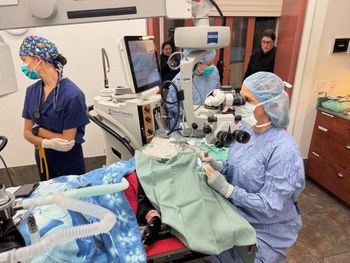
Corneal disease in dogs: there is a hole in my cornea (Proceedings)
Perforation, especially if leaking, is a definite emergency if globe is to be saved. Perforation typically has a fibrin plug, blood, iris adhered to cornea, collapsed anterior chamber, aqueous humor leakage
Topics
Dermoids, Corneal Ulcers, Trauma-induced corneal lesions, Lipid Keratopathy, Pigmentary Keratitis, Endothelial Degeneration
Corneal Ulcers
1) Superficial Ulcers
2) SCCED (superficial chronic corneal epithelial defect)
• Indolent Ulcers
• Boxer ulcers
• Non-healing ulcers
3) Complicated Ulcers
Superficial Ulcers
– Duration
• Uncomplicated ulcer will heal in 2 days
• If doesn't behave "typically" consider underlying conditions
– Age
• Young dog: distichia, ectopic cilia, entropion
• Old dog: indolent/non-healing ulcer
– Work-Up
• Fluorescein Stain
• Close look at eyelids and conjunctiva for hairs or foreign bodies
– Treatment for uncomplicated, superficial ulcers
• Topical Antibiotic
o BNP ointment/ Neo-Poly-Gramicidin
o Tobramycin drops
• Atropine
o One drop in office should be sufficient
• E Collar
– Recheck 2 - 3 days
Indolent Ulcers
– Must Haves:
• Older patient (at least 5yrs)
• Epithelial undermining (lipping edges)
• No depth – always superficial
• 1 week+ duration
– These will get smaller and larger during treatment
– Treatment options
• Corneal debridement (cotton tipped applicator)
• Linear Grid Keratotomy
• Anterior Stromal Puncture
• Diamond Burr
• Contact lens
– Medications
• Tobramycin or Ofloxacin
• Atropine
• E Collaran
• Tramadolan
– Recheck
• 2 weeksan
• Do not re-debride before 2 weeks
– Mistakes I see:
• Debriding deep ulcers
• Deep linear grid lacerations
• Treating with one antibiotic and then changing because the ulcer didn't heal ... the scarring is going to get worse and worse
• Debriding young dogs .... There is an underlying cause for young dogs not healing
Complicated Ulcers: Deep Stromal Ulcers / Perforations / Melting Ulcers
– These are Corneal Emergencies
– Descemetocele is a impending perforation: ulcer to the depth of endothelial basement membrane, Peripheral Fluorescein uptake with clear center. Rarely see bulging of membrane, usually deeeeeep crater
– Perforation, especially if leaking, is a definite emergency if globe is to be saved. Perforation typically has a fibrin plug, blood, iris adhered to cornea, collapsed anterior chamber, aqueous humor leakage
– These cases can rupture in the exam room!
– They don't all look the same
– Acute perforations usually very painful
– Treatment: Prompt, careful, thorough exam, avoid excessive restraint, look for underlying cause
• Dry eye, Distichiasis, trichiasis, ectopic cilia, entropion, Foreign body (esp. behind third eyelid)
• Mineral degeneration, Facial nerve, trigeminal nerve disease, Corneal sequestrum (cat)
• Numbing the surface of the eye with topical anesthetic can be very helpful
• Examine non-painful eye first: may give clues to inciting cause of painful eye (i.e. Dry eye, extra hairs, etc.)
• Slow, careful examination of affected eye if possible
• Proper diagnostics to rule out underlying dry eye, assess depth of ulcer, etc.
– Prognostic clues:
• Presence of direct or consensual PLR
• Clear view into eye
• Size of ulcer
• Integrity of cornea
• Presence of other ocular disease such as cataracts, retinal disease, glaucoma
– Treatment - Complicated Ulcers
– These ulcers typically need surgery, True ocular emergency
– Medical Management
• Ofloxacin q 2 h
• Serum q 2 h
• Oral Antibiotics
• Oral Anti-inflammatory
• Tramadol
• Atropine BID
• E Collar
– Recheck – 24 hours
– Surgical repair options: Conjunctival pedicle flap, Corneoconjunctival transposition flap, Direct suture if lesion < 2mm, Conjunctival island graft, Conjunctival hood flap, Corneal graft, Other tectonic grafts (scleral, small intestinal sub mucosa (BIOSIS))
Melting Ulcers
– Corneal perforation within 12-24 hours if not treated aggressively
– Causes usually bacterial
• Pseudomonas aeroginosa
• Beta-hemolytic streptococcus
– Fungal uncommon in dog; common in horse
– Melting due to collagenases either from organism or self
– Examination and diagnostics: Look for underlying causes (Dry eye, lid abnormalities, hairs, ear/ skin infection, etc.), Schirmer tear test, Culture and sensitivity, Cytology, Fluorescein stain, Tonometry
Treatment and follow up
– Topical antibiotics every 1-2 hr
• Avoid ointments in case it ruptures
• Fluoroquinolones
– Topical anti-collagenase every 1-2 hr
• Serum (aseptically prepared, keep refrigerated, discard after 5 days)
• EDTA, N- acetylcysteine
• Mucomyst, tetracyclines
– Topical mydriatics
– Systemic antibiotic
– Systemic steroid or NSAID
– Pain Management
– E- COLLAR
– Treatment protocol
– Ofloxacin, ciprofloxacin q 1-2 hours
• good against gram- bacteria
• good corneal penetration
– Neomycin, polymyxin w/ bacitracin or gramicidin q 4-6 hours
• good broad spectrum activity
• poor penetration
• won't touch pseudomonas
– Atropine 1% or tropicamide 1%
• prevent synechia, ciliary spasm, stabilize blood aqueous barrier
– May need hospitalization if client unable to treat round the clock
– Follow up within 24-48 hours
Trauma Induced Corneal Lesions: Penetrating Corneal Wounds, Lacerations / Punctures, Penetrating Corneal Lacerations
– Signs: Aqueous leakage (seidel), Fibrin seal or iris prolapse, Scleral lacerations
– Avoid manipulation
– Corneal lacerations
• Lacerations that are leaking are best treated surgically ASAP
• Degree of intraocular damage and integrity of cornea will determine type of surgical treatment
• If surgery must be delayed due to other injuries, long traveling distance, etc. treat medically
– Medical treatment
• Topical antibiotic solution (NO ointments)
• Topical mydriatic solution if miotic
• Systemic anti-inflammatory to treat intraocular inflammation
• Systemic antibiotics to prevent intraocular infection
• Pain management
• E-collar
– Surgical treatment: Direct suture, Conjunctival flap, Corneal transplant with or without flap
– Complications of lacerations: Anterior/posterior synechia, Chronic uveitis, Phthisis bulbi, Secondary glaucoma, Cataract, Blindness
Crystalline Keratopathy
– Corneal Dystrophy: inherited
– Lipid Keratopathy: secondary to systemic lipid abnormalities
– Corneal Degeneration: secondary to local inflammation or irritation
– Causes
• Inherited propensity: Shetland Sheepdog, Siberian Husky, Beagles, Cavalier, Airedale, Rough Collie
• Hypothyroid dogs: do not metabolize fats appropriately
• Diet
– Work Up
• Blood work with thyroid panel, Calcium, Cholesterol, Triglyceride levels
– Treatment:
• Correct underlying problem if you find one
• Low fat diet, ask about treats!
• If stable, visual, and comfortable: leave it
– If visual deficits or chronic ulcerations refer for
• Superficial keratectomy, TCA, grafts
Pigmentary keratitis
– Brachycephalics predisposed
– Cause: chronic corneal irritation, Medial canthal entropion, KCS, Distichia, Nasal fold trichiasis, Excessive corneal exposure
– Treatment
• Address underlying cause
o Medial canthoplasty
o Tear stimulants
o Cryotherapy for distichia
• Medical Therapy
o Topical Tacrolimus
o Topical steroids
Endothelial degeneration
– Diffuse corneal edema
– Rule Outs: Glaucoma, Lipid Aqueous, Anterior Lens Luxation
– Diagnostics: Intraocular pressure, Corneal stain
– Treatment
• Sodium Chloride Ointment
• Early → Keratoleptnysis
• Late →Thermokeratoplasty
Newsletter
From exam room tips to practice management insights, get trusted veterinary news delivered straight to your inbox—subscribe to dvm360.




